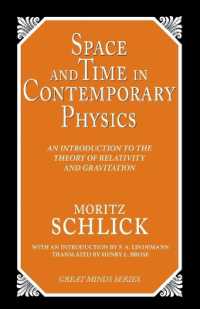Full Description
Arvey Foundation Book Award, Association for Latin American Art, 2019
Quito, Ecuador, was one of colonial South America's most important artistic centers. Yet the literature on painting in colonial Quito largely ignores the first century of activity, reducing it to a "handful of names," writes Susan Verdi Webster. In this major new work based on extensive and largely unpublished archival documentation, Webster identifies and traces the lives of more than fifty painters who plied their trade in the city between 1550 and 1650, revealing their mastery of languages and literacies and the circumstances in which they worked in early colonial Quito.
Overturning many traditional assumptions about early QuiteÑo artists, Webster establishes that these artists-most of whom were Andean-functioned as visual intermediaries and multifaceted cultural translators who harnessed a wealth of specialized knowledge to shape graphic, pictorial worlds for colonial audiences. Operating in an urban mediascape of layered languages and empires-a colonial Spanish realm of alphabetic script and mimetic imagery and a colonial Andean world of discursive graphic, material, and chromatic forms-QuiteÑo painters dominated both the pen and the brush. Webster demonstrates that the QuiteÑo artists enjoyed fluency in several areas, ranging from alphabetic literacy and sophisticated scribal conventions to specialized knowledge of pictorial languages: the materials, technologies, and chemistry of painting, in addition to perspective, proportion, and iconography. This mastery enabled artists to deploy languages and literacies-alphabetic, pictorial, graphic, chromatic, and material-to obtain power and status in early colonial Quito.
Contents
Acknowledgments
Introduction
Part I. Contexts
Chapter 1. Lettered Painters and the Languages of Empire
Chapter 2. Materials, Models, and the Market
Chapter 3. The Objects of Painting
Chapter 4. Painters and the Profession
Part II. Painters
Chapter 5. First Generations, ca. 1550-1615
Chapter 6. Pintar la figura de la letra: AndrÉs SÁnchez Gallque and the Languages of Empire
Chapter 7. Later Generations, 1615-1650
Chapter 8. Mateo MexÍa and the Languages of "Style"
Final Considerations
Appendix. Selected Transcriptions of Painting Contracts
A. Melchor de AlarcÓn, Choir Books, 1572
B. Diego de Robles and Luis de Ribera, Virgin of the Rosary, 1586
C. AndrÉs SÁnchez Gallque, Chimbo Altarpiece, 1592
D. Lucas Vizuete, Easel Paintings, 1626
E. Miguel Ponce, Altarpiece and Paintings, 1633
Glossary
Notes
Bibliography
Index







